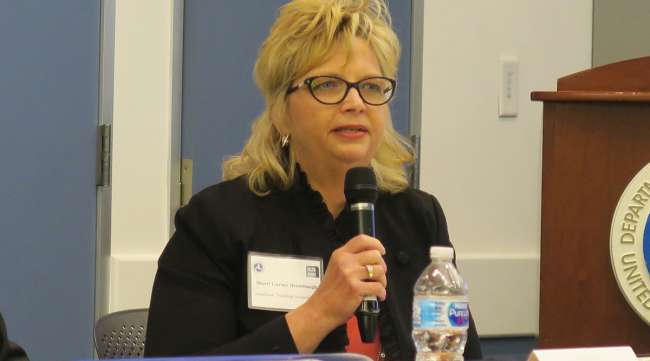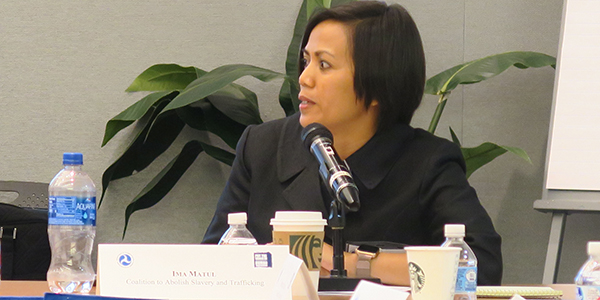Staff Reporter
Committee Against Human Trafficking Reviews Draft of Final Report

WASHINGTON — The U.S. Department of Transportation’s Advisory Committee on Human Trafficking is one step closer to submitting the final version of its capstone report.
At its third and final public meeting May 16, the committee reviewed and deliberated about the report that it ultimately will submit to Transportation Secretary Elaine Chao. The committee’s goal is to develop strategies for reporting human trafficking and craft recommendations for DOT-funded programs to combat the issue. Human trafficking, which involves the use of force to obtain labor or a commercial sex act, exploits about 25 million people, according to the draft report.
The committee, formed in October, includes leaders of organizations that fight modern slavery, as well as academics and representatives of the trucking, bus, rail, aviation, maritime and port industries. The draft report, which includes 45 pages of text and 78 pages of appendices, is titled “Combating Human Trafficking in the Transportation Sector.”
The draft report lists indicators and strategies that apply to various members of the transportation industry, including truckers and people who operate truck stops and travel centers. The report urges fleet executives to visibly support anti-trafficking initiatives, partner with organizations such as Truckers Against Trafficking and establish a timeline for training programs. Similarly, truck stop operators are encouraged to participate in public awareness campaigns and partner with law enforcement groups.
Committee member Sherri Garner Brumbaugh, president of Garner Transportation Group, said that human trafficking is an issue that truckers can help eradicate if they work together. Garner Transportation is a trucking company based in Findlay, Ohio.

Ima Matul, survivor leadership program manager at the Coalition to Abolish Slavery and Trafficking, says one sign someone could be a victim of trafficking is if they look bewildered going through security at an airport. (Eleanor Lamb/Transport Topics)
“Whether you’re CEO, whether you’re safety director, whether you’re president, you can effect change within your own organization by implementing a zero tolerance policy and holding your employees accountable,” Garner Brumbaugh, who also serves as vice chair of American Trucking Associations, told Transport Topics. “It’s a culture. It’s setting your culture of respecting human life and respecting that everyone’s someone’s mother, someone’s daughter.”
The committee’s deliberation was preceded by testimony from three human trafficking survivors, who offered guidance for people to identify illicit activity. Ima Matul, survivor leadership program manager at the Coalition to Abolish Slavery and Trafficking, said indicators include people who appear bewildered when going through security at an airport and are made to carry a family’s bags while traveling. Matul was trafficked from Indonesia at age 17 and remained enslaved as a family’s housekeeper for three years in California.
Giselle Meza, founder of Puresa Humanitarian, an organization that helps victims of sexual slavery, said people working at desks at airports and terminals should be trained to look for signs of trafficking. Meza was trapped and repeatedly raped in a woman’s London apartment for a stretch of weeks when she was 14 years old. When she escaped to the airport to flee back to the United States, she said the person at the airline counter didn’t recognize she was in trouble. After launching a successful modeling career, Meza quit to serve victims of slavery in Southeast Asia and founded her organization.

Meza
“There should be an education program in each department to teach them how to recognize a trafficking victim,” Meza said. “Education programs are so important in all these different divisions.”
Garner Brumbaugh said truck drivers are uniquely well-situated to identify and stop human trafficking because they spend so much time on the road.
“We’re on the road a lot,” Garner Brumbaugh said. “We pass through a lot of states. We are from coast to coast. We are across borders. I think we can be the eyes and ears.”
Recommendations for DOT outlined in the report include continued funding for counter-trafficking initiatives and training programs, facilitation of focus groups and research, establishment of progress metrics and the development of a model for reporting protocol.
The committee will continue to deliberate on designs for signage that displays resources for victims, including the phone number for the National Human Trafficking Hotline. The group will meet again June 17 via teleconference and will vote on the final version of the report, which it needs to submit to Transportation Secretary Elaine Chao by July 3. Chao may accept the report or return it to the committee with questions.
“I think this process has been sobering, it’s been humbling, it’s been inspirational,” said Linda Burtwistle, committee chair and CEO of Coach USA. “Our outreach is ginormous.”

